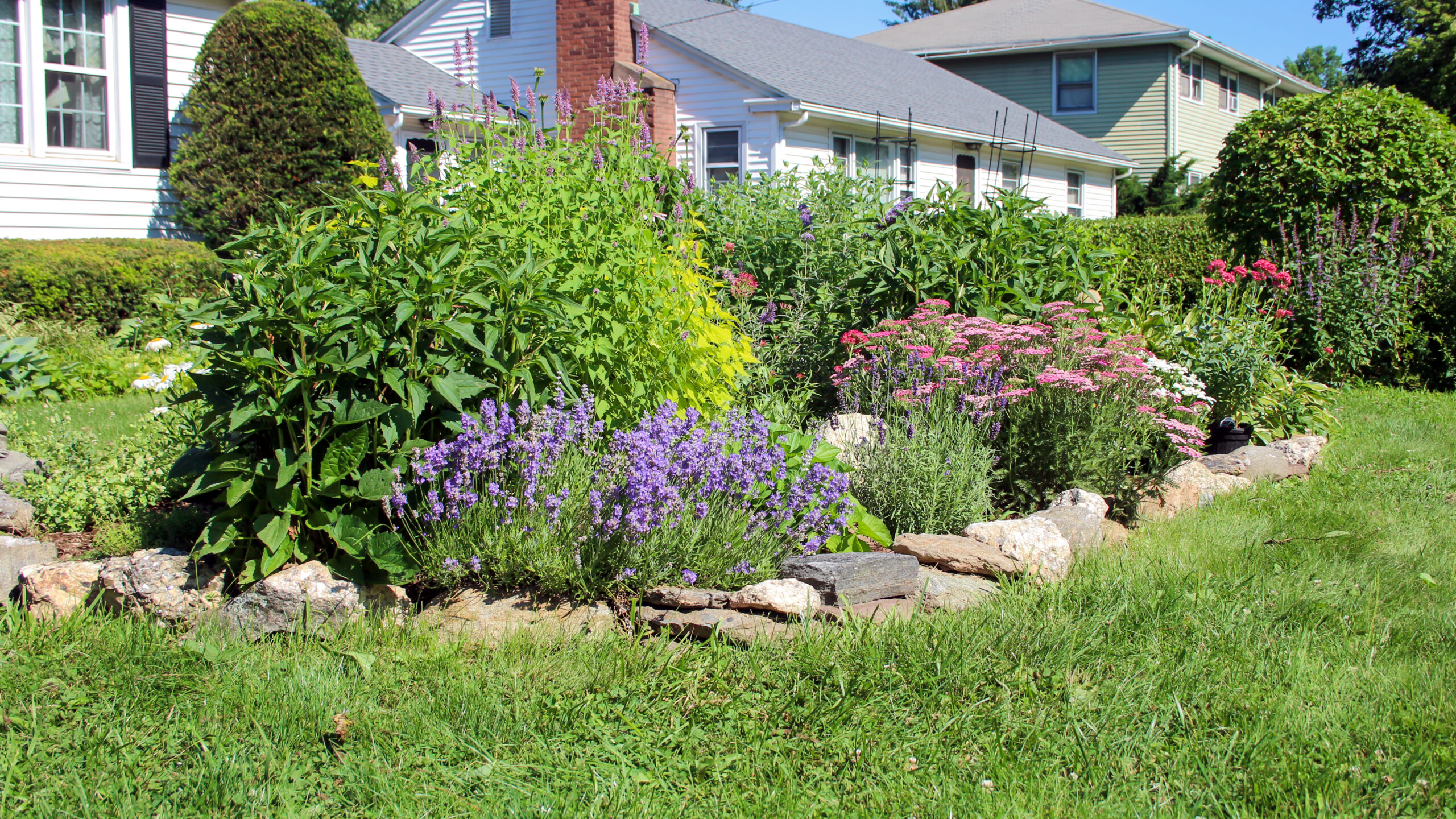By Phil LeMontagne
Years ago our front yard contained a beautiful Crabapple tree and a lovely Red Maple. Each provided abundant shade, but still allowed enough light through to maintain a healthy green lawn. We planted a Hosta garden beneath the spreading boughs.

In the dappled light this garden grew more and more lush with each passing year.
 On a rainy Spring morning, a migrating Yellow-bellied Sapsucker drilled a series of holes into the trunk of the Crabapple tree. A few of years later the tree succumbed to a disease which caused the bark to fall away near the woodpecker holes. Sadly, the beautiful tree had to be taken down.
On a rainy Spring morning, a migrating Yellow-bellied Sapsucker drilled a series of holes into the trunk of the Crabapple tree. A few of years later the tree succumbed to a disease which caused the bark to fall away near the woodpecker holes. Sadly, the beautiful tree had to be taken down.
As fate would have it, later that year the power company found it necessary to remove the Red Maple because it was encroaching on their power lines. We were not too upset though, because the power line to our house ran right through the middle of that tree!
Unfortunately, this left our front yard with no trees and no shade. The Hosta garden suffered in the bright sunshine, and the yard began to exhibit a decided lack of character. We weren’t sure what to do about it.
We thought about this for some time when, by chance, a flier from the Xerces Society arrived in the mail which promoted planting gardens to support declining pollinator populations. The answer to our problem was suddenly clear. We should plant a Pollinator Garden!

Polinator Garden
Nancy, at Ballek’s Garden Center helped us with our creation. She designed the layout using a variety of plants that we would not have considered, mixing textures and colors in interesting and complimentary ways. While the goal was to provide food and habitat for pollinators, the resulting garden turned out to be quite pleasing to the eye.

That first year the garden was extraordinarily successful, and wildly exceeded our expectations. All Summer long we were delighted by discoveries we made as we explored the wonderful world of pollinators. Bees are just a part of that world, albeit a very important part. The decline of native Honeybees actually became headline news when it began to effect the pollination of important food crops.

Western Honey Bee (Apis mellifera)
Certainly more needs to be done. We can help reverse the trend by providing more habitat for hardworking species like this Long Horned Bee.

We learned that, in addition to bees, a large number of fly species are pollinators. They range in size from tiny Toxomerus Syrphid Flies, to giant Mydas Flies, with a great variety of species of every size in between.

Syrphid Fly (Toxomeris marginatus)

Mydas Fly (Mydas maculiventris)
Equally interesting was the number of beetles to be found crawling on the leaves and blossoms, from Wedge-shaped Beetles with fancy antennae, to tiny, but fierce looking Spotted Cucumber Beetles.

 Other pollinators we saw included a large assortment of Wasps and Moths.
Other pollinators we saw included a large assortment of Wasps and Moths.


Hummingbird Clearwing Moth (Hemaris thysbe)
While not many birds are pollinators, some helped by spreading flower seeds in the Fall.

There were predators in the garden too!

Praying Mantis (Mantis religiosa)
The greatest thrill provided by our garden came one day in early October when the Butterfly Bush was literally covered with the showiest of all pollinators. We counted twelve butterflies on this side of the bush, but many more were out of sight on the other side! We were amazed at the attractive power of this little pollinator garden.

Monarch Butterfly (Danaus plexippus) Painted Lady Butterfly (Vanessa cardui)
 The most important plant in the garden, from a pollinators’ perspective, turned out to be the Hoary Mountain Mint. Although they can be trouble because they spread very quickly, our patch of this nondescript plant with clusters of tiny flowers attracts more insects than the rest of the garden combined! Please view the video below to see for yourself.
The most important plant in the garden, from a pollinators’ perspective, turned out to be the Hoary Mountain Mint. Although they can be trouble because they spread very quickly, our patch of this nondescript plant with clusters of tiny flowers attracts more insects than the rest of the garden combined! Please view the video below to see for yourself.

As you have seen, a pollinator garden can be quite beautiful while also serving as an important resource for pollinating insects. It can offer many opportunities for discovery and provide a positive connection to the natural world. Perhaps there is a sunny spot in your yard for a small pollinator garden where you can help us and the Xerces Society protect a very important natural resource.

Plant species used in the Pollinator Garden.
Black-eyed Susan (Rudbeckia hirta)
Lavender (Lavandula agustifolia) “Lavance”
Lavender (Lavandula agustifolia) “Hidcote Blue”
Agastache (Agastache) “Purple Haze”
Agastache (Agastache) “Golden Jubilee”
Purple Cone Flower (Echinacea purpurea)
Lemon Thyme (Thymus x citriodorus) “Archers Gold”
Lemon Variegated Thyme (Thymus x citriodorus aureus)
Basil Herbalea (Ocimum hybrid) “Snow White”
Oregano (Oreganum rotundifolium) “Kent Beauty”
Yarrow (Achillea millefolium)
Pink Centranthus (Centranthus ruber) “Jupiter’s Beard”
Dwarf Yellow Rose Bush “Sunblaze”
Butterfly Bush (Buddleia) “Glass Slippers”
Sedum (Hylotelephium telephium) “Autumn Joy”
Bee Balm (Monarda didyma) “Petite Wonder”
Shasta Daisy (Leucanthemum superbum) “Highland White Dream”
Shasta Daisy (Leucanthemum superbum) “Snow Lady”
Blazing Star (Liatris spicata) “Kobold Original”
Catmint (Nepeta × faassenii) “Junior Walker”
Hoary Leaf Mountain Mint (Pycanthemum Muticum)
An existing Hosta was incorporated into the garden also.













